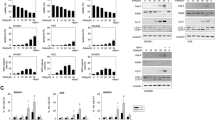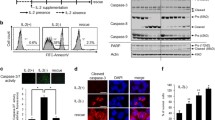Abstract
Apoptosis is modulated by extrinsic and intrinsic signaling pathways through the formation of the death receptor-mediated death-inducing signaling complex (DISC) and the mitochondrial-derived apoptosome, respectively. Ino-C2-PAF, a novel synthetic phospholipid shows impressive antiproliferative and apoptosis-inducing activity. Little is known about the signaling pathway through which it stimulates apoptosis. Here, we show that this drug induces apoptosis through proteins of the death receptor pathway, which leads to an activation of the intrinsic apoptotic pathway. Apoptosis induced by Ino-C2-PAF and its glucosidated derivate, Glc-PAF, was dependent on the DISC components FADD and caspase-8. This can be inhibited in FADD−/− and caspase-8−/− cells, in which the breakdown of the mitochondrial membrane potential, release of cytochrome c and activation of caspase-9, -8 and -3 do not occur. In addition, the overexpression of crmA, c-Flip or dominant negative FADD as well as treatment with the caspase-8 inhibitor z-IETD-fmk protected against Ino-C2-PAF-induced apoptosis. Apoptosis proceeds in the absence of CD95/Fas-ligand expression and is independent of blockade of a putative death-ligand/receptor interaction. Furthermore, apoptosis cannot be inhibited in CD95/Fas−/− Jurkat cells. Expression of Bcl-2 in either the mitochondria or the endoplasmic reticulum (ER) strongly inhibited Ino-C2-PAF- and Glc-PAF-induced apoptosis. In conclusion, Ino-C2-PAF and Glc-PAF trigger a CD95/Fas ligand- and receptor-independent atypical DISC that relies on the intrinsic apoptotic pathway via the ER and the mitochondria.









Similar content being viewed by others
References
Guner D, Belka C, Daniel PT (2003) Disruption of cell death signaling in cancer: impact on disease prognosis and response to therapy. Curr Med Chem Anticancer Agents 3:319–326
Hajra KM, Liu JR (2004) Apoptosome dysfunction in human cancer. Apoptosis 9:691–704
Danker K, Reutter W, Semini G (2010) Glycosidated phospholipids: uncoupling of signalling pathways at the plasma membrane. Br J Pharmacol 160:36–47
de Mendoza AE, Campanero MA, de la Iglesia-Vicente J, Gajate C, Mollinedo F, Blanco-Prieto MJ (2009) Antitumor alkyl ether lipid edelfosine: tissue distribution and pharmacokinetic behavior in healthy and tumor-bearing immunosuppressed mice. Clin Cancer Res 15:858–864
Gajate C, Gonzalez-Camacho F, Mollinedo F (2009) Lipid raft connection between extrinsic and intrinsic apoptotic pathways. Biochem Biophys Res Commun 380:780–784
Gajate C, Mollinedo F (2002) Biological activities, mechanisms of action and biomedical prospect of the antitumor ether phospholipid ET-18-OCH(3) (edelfosine), a proapoptotic agent in tumor cells. Curr Drug Metab 3:491–525
Gajate C, Santos-Beneit AM, Macho A et al (2000) Involvement of mitochondria and caspase-3 in ET-18-OCH(3)-induced apoptosis of human leukemic cells. Int J Cancer 86:208–218
Mollinedo F, de la Iglesia-Vicente J, Gajate C et al (2010) Lipid raft-targeted therapy in multiple myeloma. Oncogene 29:3748–3757
Mollinedo F, Gajate C, Morales AI et al (2009) Novel anti-inflammatory action of edelfosine lacking toxicity with protective effect in experimental colitis. J Pharmacol Exp Ther 329:439–449
Noseda A, White JG, Godwin PL, Jerome WG, Modest EJ (1989) Membrane damage in leukemic cells induced by ether and ester lipids: an electron microscopic study. Exp Mol Pathol 50:69–83
Mickeleit M, Wieder T, Buchner K, Geilen C, Mulzer J, Reutter W (1995) Glc-PC, a new type of glucosidic phospholipid. Angew Chem Int Ed 34:2667–2669
Mickeleit M, Wieder T, Arnold M, Geilen C, Mulzer J, Reutter W (1998) A glucose-containing ether lipid (Glc-PAF) as an antiproliferative analog of the platelet activating factor. Angew Chem Int Ed 37:351–353
Fischer A, Muller D, Zimmermann-Kordmann M et al (2006) The ether lipid inositol-C2-PAF is a potent inhibitor of cell proliferation in HaCaT cells. Chembiochem 7:441–449
Belka C, Rudner J, Wesselborg S et al (2000) Differential role of caspase-8 and BID activation during radiation- and CD95-induced apoptosis. Oncogene 19:1181–1190
Eischen CM, Kottke TJ, Martins LM et al (1997) Comparison of apoptosis in wild-type and Fas-resistant cells: chemotherapy-induced apoptosis is not dependent on Fas/Fas ligand interactions. Blood 90:935–943
Klopfer A, Hasenjager A, Belka C, Schulze-Osthoff K, Dorken B, Daniel PT (2004) Adenine deoxynucleotides fludarabine and cladribine induce apoptosis in a CD95/Fas receptor, FADD and caspase-8-independent manner by activation of the mitochondrial cell death pathway. Oncogene 23:9408–9418
Newton K, Strasser A (2000) Ionizing radiation and chemotherapeutic drugs induce apoptosis in lymphocytes in the absence of Fas or FADD/MORT1 signaling. Implications for cancer therapy. J Exp Med 191:195–200
von Haefen C, Wieder T, Essmann F, Schulze-Osthoff K, Dorken B, Daniel PT (2003) Paclitaxel-induced apoptosis in BJAB cells proceeds via a death receptor-independent, caspases-3/-8-driven mitochondrial amplification loop. Oncogene 22:2236–2247
Wesselborg S, Engels IH, Rossmann E, Los M, Schulze-Osthoff K (1999) Anticancer drugs induce caspase-8/FLICE activation and apoptosis in the absence of CD95 receptor/ligand interaction. Blood 93:3053–3063
Wieder T, Essmann F, Prokop A et al (2001) Activation of caspase-8 in drug-induced apoptosis of B-lymphoid cells is independent of CD95/Fas receptor-ligand interaction and occurs downstream of caspase-3. Blood 97:1378–1387
Starck L, Scholz C, Dorken B, Daniel PT (2005) Costimulation by CD137/4-1BB inhibits T cell apoptosis and induces Bcl-xL and c-FLIP(short) via phosphatidylinositol 3-kinase and AKT/protein kinase B. Eur J Immunol 35:1257–1266
Mollinedo F, de la Iglesia-Vicente J, Gajate C et al (2010) In vitro and In vivo selective antitumor activity of Edelfosine against mantle cell lymphoma and chronic lymphocytic leukemia involving lipid rafts. Clin Cancer Res 16:2046–2054
Mollinedo F, Fernandez-Luna JL, Gajate C et al (1997) Selective induction of apoptosis in cancer cells by the ether lipid ET-18-OCH3 (Edelfosine): molecular structure requirements, cellular uptake, and protection by Bcl-2 and Bcl-X(L). Cancer Res 57:1320–1328
Wiese A, Wieder T, Mickeleit M et al (2000) Structure-dependent effects of glucose-containing analogs of platelet activating factor (PAF) on membrane integrity. Biol Chem 381:135–144
Wieder T, Orfanos CE, Geilen CC (1998) Induction of ceramide-mediated apoptosis by the anticancer phospholipid analog, hexadecylphosphocholine. J Biol Chem 273:11025–11031
Tsujimoto Y, Shimizu S (2005) Another way to die: autophagic programmed cell death. Cell Death Differ 12(Suppl 2):1528–1534
Cabaner C, Gajate C, Macho A, Munoz E, Modolell M, Mollinedo F (1999) Induction of apoptosis in human mitogen-activated peripheral blood T-lymphocytes by the ether phospholipid ET-18-OCH3: involvement of the Fas receptor/ligand system. Br J Pharmacol 127:813–825
Gajate C, Fonteriz RI, Cabaner C et al (2000) Intracellular triggering of Fas, independently of FasL, as a new mechanism of antitumor ether lipid-induced apoptosis. Int J Cancer 85:674–682
Grobner S, Adkins I, Schulz S et al (2007) Catalytically active Yersinia outer protein P induces cleavage of RIP and caspase-8 at the level of the DISC independently of death receptors in dendritic cells. Apoptosis 12:1813–1825
van der Luit AH, Vink SR, Klarenbeek JB et al (2007) A new class of anticancer alkylphospholipids uses lipid rafts as membrane gateways to induce apoptosis in lymphoma cells. Mol Cancer Ther 6:2337–2345
Gajate C, Del Canto-Janez E, Acuna AU et al (2004) Intracellular triggering of Fas aggregation and recruitment of apoptotic molecules into Fas-enriched rafts in selective tumor cell apoptosis. J Exp Med 200:353–365
Gajate C, Mollinedo F (2007) Edelfosine and perifosine induce selective apoptosis in multiple myeloma by recruitment of death receptors and downstream signaling molecules into lipid rafts. Blood 109:711–719
Jendrossek V, Muller I, Eibl H, Belka C (2003) Intracellular mediators of erucylphosphocholine-induced apoptosis. Oncogene 22:2621–2631
Nieto-Miguel T, Fonteriz RI, Vay L, Gajate C, Lopez-Hernandez S, Mollinedo F (2007) Endoplasmic reticulum stress in the proapoptotic action of edelfosine in solid tumor cells. Cancer Res 67:10368–10378
Chandra D, Choy G, Deng X, Bhatia B, Daniel P, Tang DG (2004) Association of active caspase 8 with the mitochondrial membrane during apoptosis: potential roles in cleaving BAP31 and caspase 3 and mediating mitochondrion-endoplasmic reticulum cross talk in etoposide-induced cell death. Mol Cell Biol 24:6592–6607
Xiang R, Liu Y, Zhu L, Dong W, Qi Y (2006) Adaptor FADD is recruited by RTN3/HAP in ER-bound signaling complexes. Apoptosis 11:1923–1932
Upton JP, Austgen K, Nishino M et al (2008) Caspase-2 cleavage of BID is a critical apoptotic signal downstream of endoplasmic reticulum stress. Mol Cell Biol 28:3943–3951
Lamothe B, Aggarwal BB (2002) Ectopic expression of Bcl-2 and Bcl-xL inhibits apoptosis induced by TNF-related apoptosis-inducing ligand (TRAIL) through suppression of caspases-8, 7, and 3 and BID cleavage in human acute myelogenous leukemia cell line HL-60. J Interferon Cytokine Res 22:269–279
Voorzanger-Rousselot N, Blay JY (2004) Coexpression of CD40 and CD40L on B lymphoma and carcinoma cells: an autocrine anti-apoptotic role. Leuk Lymphoma 45:1239–1245
Nieto-Miguel T, Gajate C, Mollinedo F (2006) Differential targets and subcellular localization of antitumor alkyl-lysophospholipid in leukemic versus solid tumor cells. J Biol Chem 281:14833–14840
Marini P, Denzinger S, Schiller D et al (2006) Combined treatment of colorectal tumours with agonistic TRAIL receptor antibodies HGS-ETR1 and HGS-ETR2 and radiotherapy: enhanced effects in vitro and dose-dependent growth delay in vivo. Oncogene
Marini P, Schmid A, Jendrossek V et al (2005) Irradiation specifically sensitises solid tumour cell lines to TRAIL mediated apoptosis. BMC Cancer 5:5
von Haefen C, Gillissen B, Hemmati PG et al (2004) Multidomain Bcl-2 homolog Bax but not Bak mediates synergistic induction of apoptosis by TRAIL and 5-FU through the mitochondrial apoptosis pathway. Oncogene 23:8320–8332
Juo P, Kuo CJ, Yuan J, Blenis J (1998) Essential requirement for caspase-8/FLICE in the initiation of the Fas-induced apoptotic cascade. Curr Biol 8:1001–1008
Juo P, Woo MS, Kuo CJ et al (1999) FADD is required for multiple signaling events downstream of the receptor Fas. Cell Growth Differ 10:797–804
Rudner J, Lepple-Wienhues A, Budach W et al (2001) Wild-type, mitochondrial and ER-restricted Bcl-2 inhibit DNA damage-induced apoptosis but do not affect death receptor-induced apoptosis. J Cell Sci 114:4161–4172
von Haefen C, Wieder T, Gillissen B et al (2002) Ceramide induces mitochondrial activation and apoptosis via a Bax-dependent pathway in human carcinoma cells. Oncogene 21:4009–4019
Sturm I, Stephan C, Gillissen B et al (2006) Loss of the tissue-specific proapoptotic BH3-only protein Nbk/Bik is a unifying feature of renal cell carcinoma. Cell Death Differ 13:619–627
Author information
Authors and Affiliations
Corresponding author
Additional information
Peter T. Daniel and Kerstin Danker—shared senior authorship.
Rights and permissions
About this article
Cite this article
von Haefen, C., Wendt, J., Semini, G. et al. Synthetic glycosidated phospholipids induce apoptosis through activation of FADD, caspase-8 and the mitochondrial death pathway. Apoptosis 16, 636–651 (2011). https://doi.org/10.1007/s10495-011-0592-2
Published:
Issue Date:
DOI: https://doi.org/10.1007/s10495-011-0592-2




